I am simultaneously finishing a travel blog about the fantastic 4.5 month long trip Steven and I took last fall to Armenia, Georgia, Azerbaijan, much of Central Asia, and then the final six weeks in Spain and Portugal. If you're interested in checking that exciting adventure out, here's the link:
www.bergersadventures6.blogspot.com
My friend, Diane, and I had read that one of the exciting attractions in the Queenstown area was the drive up Skippers Canyon. It was the ONLY road in all of New Zealand, however, that rental car companies don't insure because the twisty, narrow, unsealed road was fraught with slips and vertical drops! That was why we'd chosen Queenstown Heritage Tours to take us through the canyon. Our driver cum guide was Wolfgang, a German farmer who emigrated to NZ to work on a farm back in 1985. He changed to working as a guide about a dozen years ago. Not far out of town, Wolfy as he preferred to be called, told us and the Australian/Romanian couple with us that he hoped none of us had a problem with heights that day because, if so, we were on the wrong tour!
Wolfy jumped out of the car when he spotted a new fir tree wilding growing. He remarked every day or two when he was out on a tour, he 'has' to pull out one of the pesky fir trees. A short while later we saw a sign encouraging people to help by pulling out any wilding seedlings they see growing.
While Wolfy set up our 'morning tea' he told us to make use of the time to wander around the renovated settlement. It was so nice to get out and stretch our legs especially since we were on level ground with no cliffs nearby to look over!
Information inside the school mentioned that Skippers was never a mining town in the usual sense with a main street lined with hotels and stores and populated by miners on a drunken spree. The settlement was dispersed across the limited flat ground available on a few terraces.
www.bergersadventures6.blogspot.com
My friend, Diane, and I had read that one of the exciting attractions in the Queenstown area was the drive up Skippers Canyon. It was the ONLY road in all of New Zealand, however, that rental car companies don't insure because the twisty, narrow, unsealed road was fraught with slips and vertical drops! That was why we'd chosen Queenstown Heritage Tours to take us through the canyon. Our driver cum guide was Wolfgang, a German farmer who emigrated to NZ to work on a farm back in 1985. He changed to working as a guide about a dozen years ago. Not far out of town, Wolfy as he preferred to be called, told us and the Australian/Romanian couple with us that he hoped none of us had a problem with heights that day because, if so, we were on the wrong tour!
Queenstown, he said, was discovered in 1860 and two years later two men found a significant amount of gold in the nearby Shotover River. There were no native trees then - all the trees were introduced from overseas with sycamore and poplar trees coming from Europe. This was the native look of the area without any of the wildings we'd learned about yesterday.
Behind the gold miners in this spectacular valley was a hardy community of pioneers. Julien Bourdeau was a French-Canadian packer who served the remote communities of Maori Point, Skippers and Bullendale as a general storekeeper, farmer and mailman. For 50 years, until his death at the age of 87 in 1916, he made twice weekly return trips to Queenstown which each took two days carrying passengers and packing in supplies with his trusty horses Dobbin and Darky.
The overlook into the valley and the mountains that surrounded Queenstown was pretty magnificent. Australians come to Queenstown in big numbers, according to Wolfy, because it's a big party town and they can ski in these mountains so close to the city during the winter months of June-August.
At the beginning of Skippers Canyon were the first non-native plants we saw.
When gold was first discovered in the canyon, there were fewer than 100 people living there and horses brought in supplies. The mountain in the background was called Mt. Auram which was Latin for gold.
It took 17 years for Chinese miners to build this road. Wolfy commented that we were lucky as a grader had been here just the day before so the road was smoother than normal.The road was the worst when it rains as it's so slippery then.
Just ahead was Hell's Gate and beyond it, not surprisingly, was Heaven's Gate!
All we could say was "Thank God" we weren't in the van when Wolfy decided to park here and suggested we get out and walk through both Hell and Heaven!
None of us took any chances by walking too close to the edge of the cliff as it was a lonnnnnnnnnnng way down.
The path on the other side was for cattle to be brought to market in the fall and had been the original path in the canyon.
The van from another angle after walking down the road a fair piece!
Wolfy explained that non-native Douglas Fir trees grow up to 50 meters a year and they take nutrients and sunlight from native plants. Similarly non-native Beech trees grow up to 20 meters a year. Thirty thousand seeds are spread each year by a single mature fir tree. As the very acidic Douglas fir trees are considered to be such a pest and threat to native plants, they have been poisoned by helicopters from the air for the last ten years in New Zealand at a cost of NZD$10 million. When I questioned Wolfy about the government's attempt to eradicate all the non-native trees through the use of chemicals, he was emphatic that the selective herbicide used didn't affect surrounding plants and the spraying was critical for the re-growth of native plants and shrubs.
This was the first time in the canyon where we could see the stark difference of trees that had and hadn't been sprayed: the reddish ones were the sprayed trees. Wolfy stressed that no native trees could be cut down except by the Maori people who use the totara trees for carving.
Wolfy pointed out native tussocks on another hillside.
Back in the van, we continued the hair-raising drive through the canyon. I was beside Wolfy in the front seat and there were many times throughout the drive I remember closing my eyes and holding onto the door handle very tightly. He told us it wasn't worth wearing seat belts with the inference that, if we were to go over the cliff, we'd be goners and the seat belts wouldn't help us! That wasn't very reassuring, especially when he added he didn't want to discuss the number of people who had gone over the cliff.
This was Mt. Dewar's. I wondered if it had been named after the Scotch whiskey.
Wolfy pointed out the faint blue paint on the rock from a trailer who'd gotten too close.
These reddish 'blobs' were Douglas firs that had been poisoned a year ago. We were told the process for the trees to completely lose their color as we'd seen the day before was very slow.
This was the starkest sight we'd yet seen of an area in which so many fir trees had been eradicated at various times. Wolfy explained that in New Zealand "only a dead possum was a good possum as they eat millions of good trees' leaves a night." I remember someone else in the same vein saying to us another time that the more possums we could kill while driving at night, the better off the country would be!
Wolfy stopped next at the site of the Welcome Home Hotel that had first opened in 1863. The hotel had been a popular and thriving business and was frequented by many miners, tourists and shepherds that passed by on their way to and from Queenstown. It burned down in 1930 and was rebuilt but closed down in 1942. It was dismantled in the late 1940s. Its building materials were used to build a structure near Lake Hayes which Diane and I had walked partially around yesterday en route to Queenstown. All that remained were its chimneys and foundation steps.
As this area of the canyon gets no sun for two and a half months all winter long, the road was even more treacherous so the tours don't operate as it is so icy.
This was our first glimpse of the gorgeous Shotover River which was a favorite spot for rafters and for jet boat operators until a recent accident that had caused severe injuries for nine passengers. The bushes in the foreground were red berry oregano, Wolfy said.
Just behind the oregano plants Wolfy showed us a massive Hawthorne.
The tall plants were king's candle. I wasn't sure whether they were native or non-native. Diane - do you remember by chance?
Wolfy joked that this was Skippers B&B; in reality it belonged to a loner who'd been living there since 1995.
Unfortunately I just missed being able to catch a photo of the rafters who had just gone around the bend in the river. That likely happened because I was really, really close to the edge and had looked away for a few moments!
Not only did Wolfy recount amusing stories and lots of interesting facts about Queenstown history but he shared his love for nature and the plants we saw in the canyon. These were cats' paw.
The flat expanse of rocks was where the rafting tours departed from in the canyon.
Another pretty shot of the very attractive oregano that grew all along the roadside.
Wolfy stopped by the cliff to show us where holes had been drilled into the rocks to allow water to then be poured in so it would freeze. The resulting ice would make the rocks expand to make it easier to chip away at the soft rock wall when the road was being built.
I hope you can get a sense of how very soft the shale rock was from this photo; we watched as Wolfy was able to just crumble pieces of it off the wall.
Do you think I was close enough to the edge?!! This was why rental car companies had made only this one road exempt from travel insurance.
In 1994 a pipeline was built to carry fresh water along the Shotover River for the people living along it.
At 102 meters high, the bridge above the river was the highest bungy jump in the world at the time. Wolfy said he was one of those who jumped off the bridge - better him than me!
On the other side of the river were a stand of poplar trees. On the flat piece of land in front of the trees there used to be three pubs in the area's gold mining days.
This dead-looking bush was broom, Wolfy told us.
We stopped for several minutes at Maori Point, the spot where gold was discovered in 1862. During the height of the gold rush, the town of Maori Point was the major center in the Shotover Valley and it developed on both sides of the river. By September 1863, there were two butchers, a baker, library, five stores and a hotel on this side of the river. On the other side was the police camp, the Bank of New Zealand gold office, three stores, a baker and the courthouse.
Eventually there would be six hotels at Maori Point or Charlestown as it was sometimes known. Early communication between the two settlements was via ferry made out of two hollowed out logs pulled across the river on a bullock hide rope. The ferry was replaced by the first bridge in December 1863.
At its height during the winter of 1863, Maori Point had a population of about 2,000. However, the population soon declined as the miners were attracted to other rushes. As the miners left, the businesses also closed down with the last one closing down in 1895 and the last hotel burning down in 1901.
As we continued driving in the canyon, we came to a spot where it seemed all we could see was hill after hill of dead wildings. What a sad sight. Wolfy said the boom spraying caused the fir trees to die but didn't affect the lighter green clumps of tussocks around them.
Not long after that we had great views of Skippers Terraces on the far side of the river. Four thousand miners used to live on the only flat land on both sides of the river.
Wolfy stopped so he could show us the vein of quartz that ran across the road and up the cliff.
We stopped next at Wong Gong Terrace named for a man who came from the Four Counties area of Guangdong, China, after leaving his wife and three sons to spend the last 26 of his life in New Zealand before dying at the age of 49 and being buried in Queenstown Cemetery. Gong had a market garden here but he was also a storekeeper and interpreter for the Chinese community in Arrowtown, outside of Queenstown. By 1878 there were 5,000 Chinese and all but 5 were men!
Wolfy commented that it was a simple marketing strategy to change the name of the fruit we know as kiwis used to be known as Chinese gooseberry. As this was the beginning of their autumn, the snow line was at the height of the clouds.
It was with some trepidation that we left the very bumpy road to go over what felt like a very rickety one-way, 100-meter long bridge!
Wolfy told us the bridge had opened in 1901 and had a 72 meter drop down to the river below, not that I was looking! Back when it opened, the drop down to the river was 91 meters high. Earthquakes and sluicing had caused the river to rise. He assured us the timbers on the bridge would last another 100 years and only an earthquake would cause its demise.
We then entered an area called the Skippers Township which was part of the stunning Mount Aurum Recreation Reserve. A sign there noted that the discovery of gold in 1862 brought many miners to the area and the township was named after early explorer and prospector Malcolm 'Skipper' Duncan. Skippers, an Irishman, had spent many years at sea before being credited with discovering gold at the junction of Skippers Creek and the Shotover River in late 1862. We read that the hills around us were littered with relics and treasures left behind by the miners and the settlers. Unfortunately over the last 100 years, much of the landscape had become hidden due to the spread of wilding trees.
In the middle of the settlement was Skippers School which operated from 1879-1927 and had been restored from 1989-1992. A sign informed us we were invited to look around the school and to just close the doors when we left. Unlike any historic building I am familiar with in the US, there was no guard present anywhere and indeed all the doors were open for us to explore.
In 1877 education became free and compulsory for all children. When Skippers School was built in 1879, it comprised a single classroom and the teacher's living quarters. Another room was used as the telegraph office. There were about 35 students at the school's height.
Because of the remoteness of Skippers, the teacher's position was not particularly sought after. The school had 23 teachers in just 48 years. The isolation did allow some teachers to indulge in activities that wouldn't have been possible in other schools. One was a keen gardener and each student had his or her own plot. Another teacher even developed a 9-hole golf course in the school grounds!
The caption indicated that the rugged nature of the Skippers area required ingenious solutions to bring water around the bluffs and across gorges to mining camps.
Behind some ruins from the settlement were so many more dead wildings which would be cut down within a month. Wolfy said the dead fir trees were commonly known as either Douglas firs or Oregon trees and had been brought to Scotland and then to New Zealand and also to his native Germany and the rest of the continent. He claimed the trees are equally hated there, too.
After enjoying a selection of tea, coffee, cookies, cheese and crackers, we began the drive back to Queenstown. Wolfy laughingly said this was one of 3,000 falls in NZ all called Bridal Veil Falls!
Many of you may be aware that the Lord of the Rings series was shot in New Zealand. Wolfy stopped so we could see that a scene from The Fellowship of the Ring had been filmed here crossing the river by the rock and compared it to the actual scene from the film,
He suggested we get out from the van here so we could then walk across the one-lane bridge - lucky us, ha ha!!
I know I'm biased but the views along the Shotover River were spectacular in my opinion. An astonishing 2.1 million ounces of water was taken out of the river from the sluicing gold mining process in just four years. I wondered however they could have measured that amount so accurately.
As he drove Wolfy commented that stoats were one of the most destructive animals as they kill young birds and just leave them. To New Zealanders, they're considered 'serial killers' as stoats don't eat what they kill and there is nothing that preys on them. Neither Diane nor I had heard of the animal that he compared to a weasel in North America although I just discovered stoats are also found here when I googled them. We realized the animal traps we'd seen on our walk at Lake Hayes had been to capture stoats.
The road had as many hairy turns as the river did! It was quite unnerving when Wolfy had to make way for an oncoming driver about a half-dozen times as the road was so narrow and there were many blind turns.
This was as close as I dared get to the edge. Wolfy knew his limits better than I, no doubt after years of making the same poise!
Wolfy channeled his yodeling skills and challenged us to try them out, too.
We admired the magnificent Lighthouse Rock while Wolfy found another wilding and non-native thistles to dig up!
I was glad he'd stopped and also showed us another king's candle plant so I could take a proper photo of it rather than just as we were whizzing by in the van.
Diane and I remarked how we'd chosen the perfect time to visit NZ as everything was so green and lush. This would all be brown from June through September.
A few miles from Queenstown we stopped for the last time for some incredible panoramic views. This very spiky plant was wild Spaniard. Believe me, its tips were very sharp - I know I touched them to see!
Another million dollar view of the valley and the mountains around Queenstown. Skiing, Wolfy said, started at 1651 meter-high (5,416' high) Coronet Peak.
Looking another direction we saw the 2319 meter-high (7,608' high) Mt. Remarkables.
The aptly named Double Cone Mountain was in the distance.
Wolfy cautioned us to be on the lookout for the hundreds of wild goats as we drove in the area. Before he dropped us off at our hotel, Wolfy told the four of us about Little Paradise, a garden not far from Queenstown with 4,000 varieties of roses that he urged us to see if possible. If any reader is planning to go to New Zealand, I strongly recommend you take the Queenstown Heritage Tours of Skippers Canyon - I had the time of my life there and a lot of that was due to Wolfy, our excellent guide.
Next post: We followed Wolfy's suggestion and did indeed go to Little Paradise - I can't wait to share our visit to that magical place with you!
Posted on March 31st, 2019, from out home in suburban Denver.
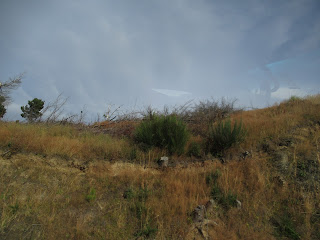























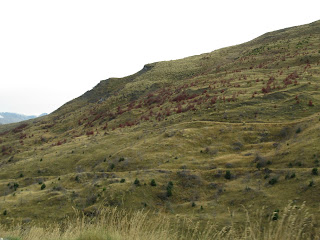


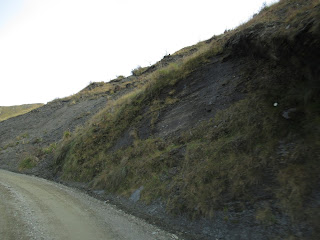










































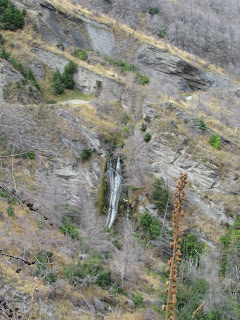

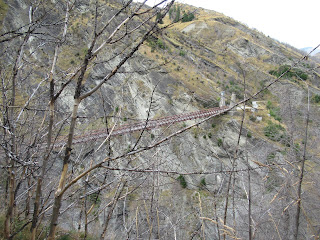



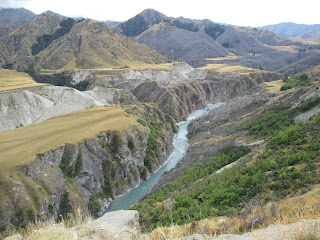









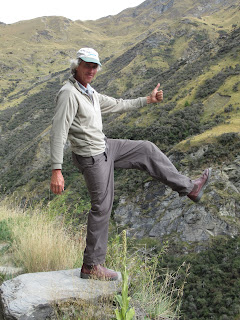














You sure have become an outdoor nature lover. It would have been fun to drive a little SmartCar or Mini Cooper on that road. The tall plant with yellow flowers is Mullein. We do have it in Colorado. Janina
ReplyDeleteJanina,
DeleteAnnie and I have always been outdoor nature lovers. We just also love big cities, small cities, museums, all places of worship and especially bazaars!
OMG! The Shotover river looks AMAZING!!! I took a screenshot of it and the post so I can add it to my list of places for the future!
ReplyDeleteIf you do ever go, perhaps you'll decide to take a jet boat ride along the river as that sounded really exciting. Make sure to take lots of photos so I can live vicariously through you, hon!
DeleteWhat a fabulous time you spent with Wolfy (love the name) .... the harrowing cliff-side drives, the spectacular Shotover river, and the many new facts you learned and shared .. New Zealanders have a "hate-n" for possums, Kiwis used to be called Chinese gooseberries and one clever teacher years ago designed a 9 hole golf course on the remote school grounds.. Loved it all .. thanks for the ride !! xoxoxo
ReplyDeleteWhoops .. small edit ... "hate-on" for possums :)
ReplyDeleteSo glad you enjoyed the 'ride' along Skippers Canyon from the comfort of your home as it was pretty hairy at times just inches from the cliffs. Wolfy was a wonderful guide - how lucky we were to have him. I am sure I shall look at kiwis the fruit in a different light the next time I see them as a result of the inventive marketing.
ReplyDelete